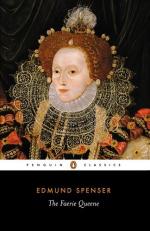I. The Plot: At the bidding of Gloriana, the Redcross Knight undertakes to deliver Una’s parents from a dragon who holds them captive. He sets out upon his quest attended by a dwarf and guided by Una, mounted on an ass and leading a lamb. They are driven by a storm into a forest, where they discover the cave of Error, who is slain by the Knight. They are then beguiled into the house of Archimago, an old enchanter. By his magic he leads the Knight in a dream to believe that Una is false to him, and thus separates them.
II. The Allegory: 1. Holiness, the love of God, united with Truth, the knowledge of God, is to deliver man from the thraldom of the Devil. Together they are able to overthrow Error; but Hypocrisy deceitfully alienates Holiness from Truth by making the latter appear unworthy of love.
2. There is a hint of the intrigues of the false Roman church and the treacherous Spanish king, Philip II, to undermine the religious and political freedom of the English people. The English nation, following the Reformed church, overthrows the Catholic faith, but is deceived by the machinations of Spanish diplomacy.
LINE 1. A GENTLE KNIGHT, the Redcross Knight, representing the church militant, and Reformed England. He is the young, untried champion of the old cause whose struggles before the Reformation are referred to in ll. 3, 4. His shield bore “a cross gules upon a field argent,” a red cross on a silver ground. See The Birth of St. George in Percy’s Reliques, iii, 3, and Malory’s Morte d’Arthur, iii, 65.
15. FOR SOVERAINE HOPE, as a sign of the supreme hope.
20. GREATEST GLORIANA, Queen Elizabeth. In other books of The Faerie Queene she is called Belphoebe, the patroness of chastity, and Britomart, the military genius of Britain.
27. A DRAGON, “the great dragon, that old serpent, called the devil,” Revelation, xii, 9, also Rome and Spain. Cf. legend of St. George and the dragon, and Fletcher’s Purple Island, vii seq.
28. A LOVELY LADIE, Una, the personification of truth and true religion. Her lamb symbolizes innocence.
46. A DWARFE, representing prudence, or common sense; according to Morley, the flesh.
56. A SHADIE GROVE, the wood of Error. “By it Spenser shadows forth the danger surrounding the mind that escapes from the bondage of Roman authority and thinks for itself.”—Kitchin. The description of the wood is an imitation of Ariosto’s Orlando Furioso, i, 37, Chaucer’s Assembly of Foules, 176, and Tasso’s Jerusalem Delivered, iii, 75. Morley sees in this grove an allegory of man’s life, the trees symbolizing trade, pleasure, youth, etc.
69. THE SAYLING PINE. Ships were built of pine.
70. THE LOPLAR NEVER DRY, because it grows best in moist soil.
71. THE BUILDER OAKE. In the Middle Ages most manor houses and churches were built of oak.




